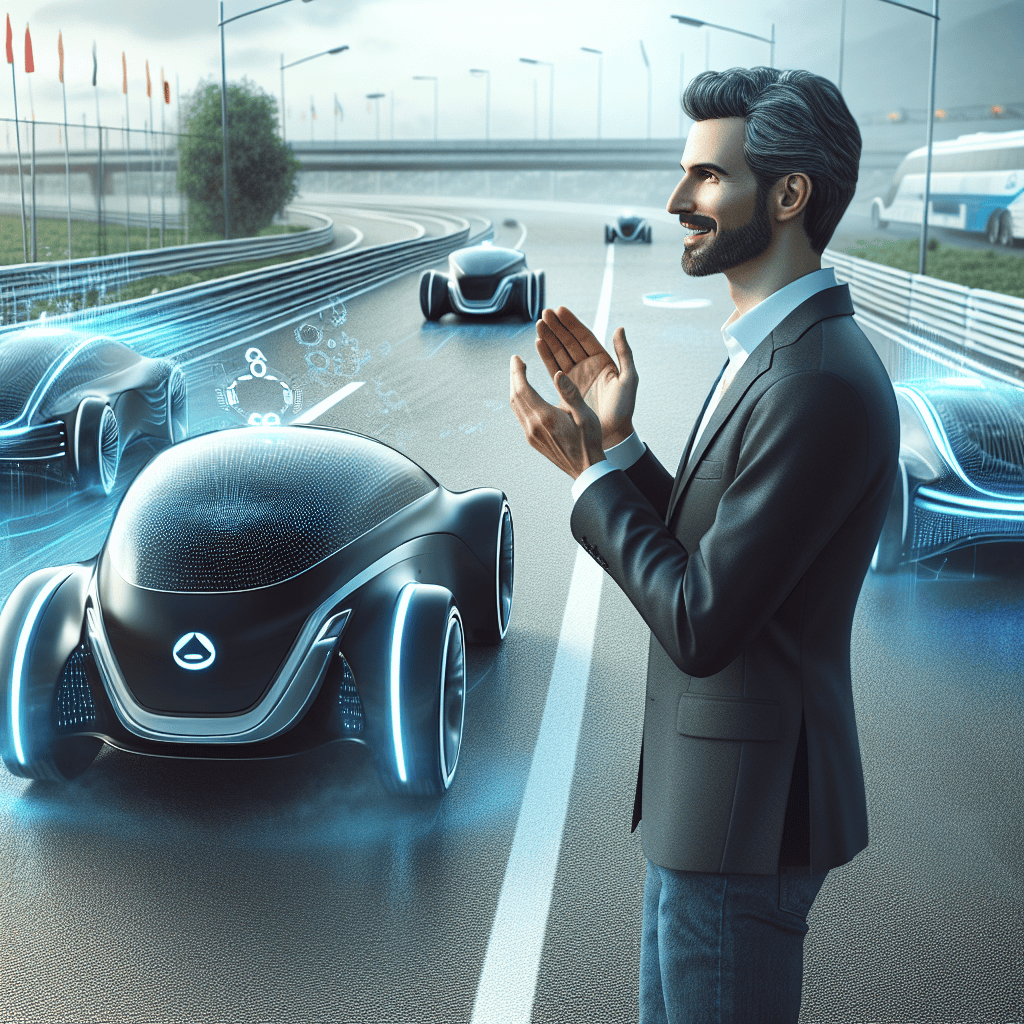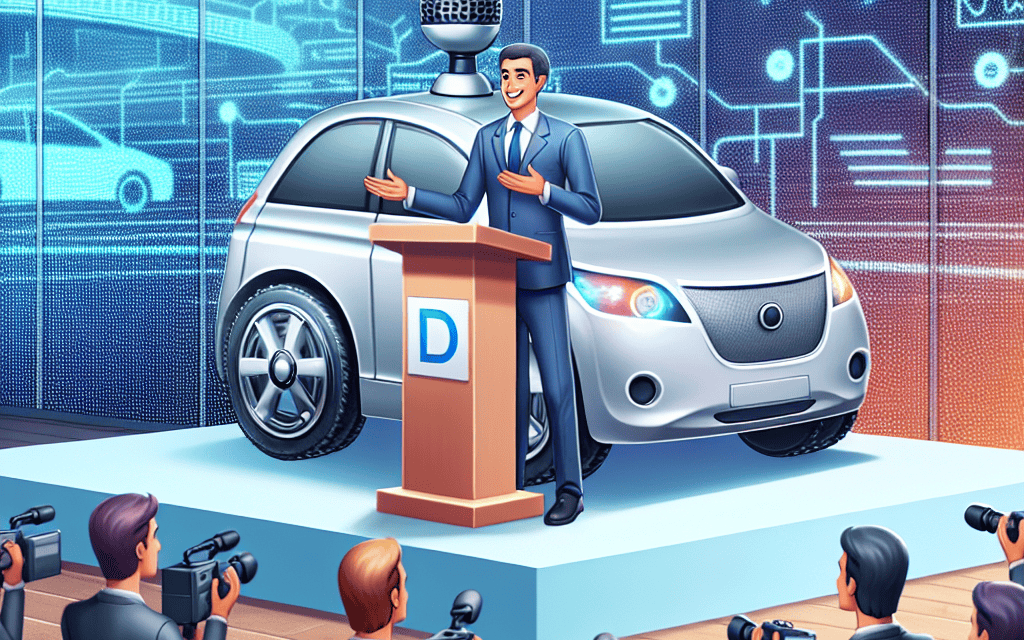“Waymo Co-founder Admits: Tesla Sets the Pace in the Autonomous Driving Revolution”
Introduction
In a notable acknowledgment within the competitive landscape of autonomous vehicle technology, a co-founder of Waymo, a leading company in the self-driving car industry, has recognized Tesla’s significant advancements in the race towards fully autonomous driving. This admission highlights the dynamic and rapidly evolving nature of the sector, where companies are striving to achieve breakthroughs in artificial intelligence and vehicular automation. Tesla, known for its innovative approach and integration of advanced driver-assistance systems, has made substantial progress, prompting industry peers to take note of its achievements. This recognition from a key figure at Waymo underscores the competitive pressures and the collaborative spirit that drive technological innovation in the pursuit of safer and more efficient transportation solutions.
Waymo’s Strategic Shift: Learning from Tesla’s Autonomous Driving Success
In the rapidly evolving landscape of autonomous driving technology, the competition among industry leaders is fierce. Recently, a notable acknowledgment came from Waymo’s co-founder, who recognized Tesla’s significant lead in the race towards fully autonomous vehicles. This admission marks a pivotal moment in the industry, as it highlights the need for strategic shifts and adaptations among competitors. Waymo, a subsidiary of Alphabet Inc., has long been considered a frontrunner in the development of self-driving technology. However, Tesla’s aggressive approach and innovative strategies have propelled it to the forefront, prompting Waymo to reassess its own methodologies.
Tesla’s success in the autonomous driving sector can be attributed to several key factors. First and foremost, the company has leveraged its vast data collection capabilities, utilizing the extensive fleet of Tesla vehicles on the road to gather real-world driving data. This data-driven approach has enabled Tesla to refine its algorithms and improve the performance of its Autopilot system. Furthermore, Tesla’s commitment to vertical integration has allowed it to maintain control over both hardware and software development, ensuring seamless integration and rapid iteration.
In contrast, Waymo has traditionally focused on a more conservative approach, prioritizing safety and rigorous testing. While this strategy has earned Waymo a reputation for reliability, it has also resulted in slower progress compared to Tesla’s more dynamic model. Recognizing this disparity, Waymo’s co-founder has emphasized the importance of learning from Tesla’s successes and adapting accordingly. This acknowledgment signifies a potential shift in Waymo’s strategic direction, as it seeks to balance safety with the need for accelerated development.
One area where Waymo can draw inspiration from Tesla is in the realm of public perception and consumer engagement. Tesla’s charismatic CEO, Elon Musk, has played a crucial role in generating excitement and interest around autonomous driving technology. By effectively communicating the potential benefits and advancements of their systems, Tesla has managed to capture the public’s imagination and build a strong brand presence. Waymo, on the other hand, has maintained a more reserved public profile, focusing primarily on partnerships with established automotive manufacturers. Moving forward, Waymo may benefit from adopting a more proactive approach in engaging with consumers and showcasing the capabilities of its technology.
Moreover, Tesla’s ability to rapidly deploy software updates over-the-air has been a game-changer in the industry. This capability allows Tesla to continuously improve its vehicles’ autonomous features without requiring physical modifications. Waymo, recognizing the advantages of such a system, may consider investing in similar technologies to enhance its own offerings. By embracing a more agile development process, Waymo can potentially accelerate its progress and remain competitive in the ever-evolving autonomous driving landscape.
In conclusion, the acknowledgment by Waymo’s co-founder of Tesla’s lead in the autonomous driving race underscores the need for strategic adaptation and learning from competitors. While Waymo has long been a pioneer in the field, Tesla’s innovative strategies and rapid advancements have set a new benchmark. By drawing inspiration from Tesla’s data-driven approach, public engagement strategies, and agile development processes, Waymo can position itself for continued success in the pursuit of fully autonomous vehicles. As the industry continues to evolve, the ability to learn from competitors and adapt accordingly will be crucial for all players in the autonomous driving race.
The Competitive Landscape: How Waymo Plans to Catch Up with Tesla
In the rapidly evolving landscape of autonomous driving technology, the competition among industry leaders is intensifying. Recently, Waymo co-founder acknowledged Tesla’s significant lead in the race to develop fully autonomous vehicles. This admission highlights the competitive dynamics between these two giants and sheds light on Waymo’s strategic plans to bridge the gap. As the autonomous driving sector continues to grow, understanding the competitive landscape is crucial for stakeholders and enthusiasts alike.
Tesla, under the leadership of Elon Musk, has made remarkable strides in the development of autonomous driving technology. The company’s Autopilot and Full Self-Driving (FSD) systems have garnered significant attention, with Tesla vehicles accumulating billions of miles in real-world driving data. This extensive data collection has been instrumental in refining Tesla’s algorithms and enhancing the performance of its autonomous systems. Consequently, Tesla’s vehicles are often perceived as being at the forefront of the autonomous driving revolution.
In contrast, Waymo, a subsidiary of Alphabet Inc., has taken a different approach. While Tesla has focused on integrating autonomous features into consumer vehicles, Waymo has concentrated on developing a comprehensive self-driving platform. This platform is designed to be implemented in a variety of applications, from ride-hailing services to logistics. Despite this strategic divergence, Waymo’s co-founder has openly recognized Tesla’s achievements, acknowledging the company’s head start in the race towards full autonomy.
However, Waymo is not resting on its laurels. The company is actively pursuing strategies to catch up with Tesla and potentially surpass it in the future. One of Waymo’s key advantages lies in its commitment to safety and rigorous testing protocols. The company has invested heavily in simulation technology, allowing it to test and refine its autonomous systems in a controlled environment. This focus on safety is a cornerstone of Waymo’s strategy, as it aims to build public trust and ensure the reliability of its technology.
Moreover, Waymo is expanding its partnerships and collaborations to accelerate its progress. By working with automotive manufacturers, technology firms, and regulatory bodies, Waymo is positioning itself to leverage external expertise and resources. These collaborations are expected to facilitate the integration of Waymo’s technology into a broader range of vehicles and applications, thereby enhancing its competitive position.
In addition to partnerships, Waymo is also investing in cutting-edge research and development. The company is exploring advancements in artificial intelligence, sensor technology, and machine learning to improve the performance and efficiency of its autonomous systems. By staying at the forefront of technological innovation, Waymo aims to close the gap with Tesla and establish itself as a leader in the autonomous driving industry.
Furthermore, Waymo’s strategic focus on diverse applications of its technology could prove advantageous in the long run. While Tesla’s consumer-focused approach has yielded impressive results, Waymo’s emphasis on a versatile platform may open up new revenue streams and market opportunities. This diversification strategy could enable Waymo to capture a larger share of the autonomous driving market as it continues to evolve.
In conclusion, the acknowledgment of Tesla’s lead by Waymo’s co-founder underscores the competitive nature of the autonomous driving industry. While Tesla has made significant progress, Waymo is actively implementing strategies to catch up and potentially surpass its rival. Through a combination of safety-focused testing, strategic partnerships, and technological innovation, Waymo is positioning itself to be a formidable contender in the race towards full autonomy. As the industry continues to advance, the competition between these two giants will undoubtedly shape the future of transportation.
Acknowledging the Leader: Waymo Co-founder’s Perspective on Tesla’s Innovations
In the rapidly evolving landscape of autonomous driving technology, the competition among industry leaders is fierce, with each company striving to outpace the others in innovation and implementation. Recently, a notable acknowledgment came from an unexpected source, as Waymo co-founder, Dmitri Dolgov, recognized Tesla’s significant advancements in the autonomous driving race. This admission is particularly striking given the competitive nature of the industry and the fact that Waymo, a subsidiary of Alphabet Inc., has long been considered a frontrunner in the development of self-driving technology.
Dolgov’s acknowledgment of Tesla’s lead is a testament to the remarkable progress the company has made under the leadership of Elon Musk. Tesla’s approach to autonomous driving is distinct, relying heavily on a vision-based system that utilizes cameras and artificial intelligence to interpret and navigate the driving environment. This method contrasts with Waymo’s strategy, which incorporates a combination of sensors, including LiDAR, radar, and cameras, to achieve a comprehensive understanding of the vehicle’s surroundings. Despite these differing methodologies, Dolgov’s recognition underscores the effectiveness of Tesla’s strategy in advancing the capabilities of autonomous vehicles.
One of the key factors contributing to Tesla’s success in this domain is its vast amount of real-world driving data. With millions of Tesla vehicles on the road, the company has access to an unparalleled dataset that is continuously updated and refined. This data is instrumental in training Tesla’s neural networks, enabling the vehicles to learn from a wide array of driving scenarios and improve their performance over time. In contrast, Waymo’s fleet, while highly sophisticated, is significantly smaller, limiting the volume of data available for analysis and development.
Moreover, Tesla’s ability to rapidly implement software updates across its fleet provides a distinct advantage. This over-the-air update capability allows Tesla to enhance its vehicles’ autonomous features swiftly, addressing any issues and introducing new functionalities without the need for physical modifications. This agility in software development and deployment is a critical component of Tesla’s strategy, allowing the company to maintain its competitive edge in the fast-paced world of autonomous driving technology.
While Dolgov’s acknowledgment of Tesla’s lead is significant, it does not diminish Waymo’s achievements and contributions to the field. Waymo has been a pioneer in autonomous driving, with a strong focus on safety and reliability. The company’s extensive testing and development processes have resulted in a robust system that has been deployed in various pilot programs and commercial applications. Waymo’s commitment to safety and its methodical approach to technology development continue to set high standards in the industry.
In conclusion, the recognition of Tesla’s advancements by a key figure from Waymo highlights the dynamic nature of the autonomous driving industry. It serves as a reminder that innovation is not confined to a single approach or methodology. As companies like Tesla and Waymo continue to push the boundaries of what is possible, the ultimate beneficiaries will be consumers, who stand to gain from safer, more efficient, and more accessible transportation options. The race for autonomous driving supremacy is far from over, and the ongoing competition will undoubtedly drive further advancements and breakthroughs in the years to come.
The Future of Autonomous Vehicles: Insights from Waymo and Tesla

In the rapidly evolving landscape of autonomous vehicles, the competition between industry giants is intensifying, with Waymo and Tesla often at the forefront of discussions. Recently, a notable acknowledgment came from Waymo’s co-founder, who recognized Tesla’s significant advancements in the autonomous driving race. This admission sheds light on the dynamic interplay between these two leading companies and offers insights into the future of autonomous vehicles.
Waymo, a subsidiary of Alphabet Inc., has long been considered a pioneer in the field of self-driving technology. With its roots tracing back to the Google Self-Driving Car Project, Waymo has consistently emphasized a cautious and methodical approach to developing fully autonomous vehicles. The company has invested heavily in creating a comprehensive suite of sensors, including LiDAR, radar, and cameras, to ensure the highest level of safety and reliability. This strategy has positioned Waymo as a leader in deploying autonomous ride-hailing services in select cities, where its vehicles operate without human intervention.
On the other hand, Tesla has taken a different path, focusing on a more incremental approach to autonomy. Tesla’s Autopilot and Full Self-Driving (FSD) systems are designed to assist drivers rather than replace them entirely. By leveraging a vast network of vehicles already on the road, Tesla continuously collects data to improve its algorithms and enhance the capabilities of its systems. This approach has allowed Tesla to rapidly iterate and deploy new features, keeping it at the cutting edge of autonomous driving technology.
The acknowledgment from Waymo’s co-founder highlights Tesla’s ability to innovate and adapt quickly in a highly competitive market. While Waymo has prioritized safety and regulatory compliance, Tesla has pushed the boundaries of what is possible, often sparking debates about the balance between innovation and safety. This recognition underscores the importance of diverse strategies in advancing autonomous vehicle technology, as each company brings unique strengths to the table.
Moreover, the competition between Waymo and Tesla is not merely a race to achieve full autonomy but also a broader contest to shape the future of transportation. As both companies continue to develop their technologies, they are also influencing public perception and regulatory frameworks. Waymo’s cautious approach has helped build trust among regulators and the public, while Tesla’s bold moves have sparked conversations about the potential and limitations of current technology.
Looking ahead, the future of autonomous vehicles will likely be shaped by a combination of these approaches. The industry may see a convergence of Waymo’s emphasis on safety and Tesla’s focus on rapid innovation. As technology continues to advance, collaboration between companies, regulators, and other stakeholders will be crucial in addressing the challenges and opportunities that lie ahead.
In conclusion, the acknowledgment from Waymo’s co-founder of Tesla’s lead in the autonomous driving race is a testament to the dynamic nature of the industry. It highlights the diverse strategies employed by leading companies and underscores the importance of innovation, safety, and collaboration in shaping the future of transportation. As Waymo and Tesla continue to push the boundaries of what is possible, the world watches with anticipation, eager to see how these advancements will transform the way we move.
Waymo’s Response to Tesla’s Dominance in the Self-Driving Market
In the rapidly evolving landscape of autonomous driving technology, the competition among industry leaders is fierce. Recently, a notable acknowledgment came from Waymo’s co-founder, who recognized Tesla’s significant lead in the self-driving market. This admission has sparked discussions about the strategies and innovations that Waymo might employ to respond to Tesla’s dominance. As the race to perfect autonomous driving intensifies, understanding the dynamics between these two giants offers valuable insights into the future of transportation.
Tesla, under the leadership of Elon Musk, has made remarkable strides in the development of autonomous vehicles. The company’s approach, which heavily relies on a vision-based system using cameras and neural networks, has set it apart from competitors. Tesla’s Full Self-Driving (FSD) software, although still in its beta phase, has been a focal point of its strategy, promising a future where cars can navigate complex environments with minimal human intervention. This progress has not gone unnoticed by Waymo, a subsidiary of Alphabet Inc., which has been a pioneer in the field of self-driving technology.
Waymo’s approach to autonomous driving differs significantly from Tesla’s. The company has invested heavily in a combination of LiDAR, radar, and cameras to create a comprehensive sensor suite that provides a detailed understanding of the vehicle’s surroundings. This method, while considered more conservative, has been praised for its safety and reliability. However, the acknowledgment of Tesla’s lead suggests that Waymo is aware of the need to adapt and innovate to maintain its position in the market.
In response to Tesla’s advancements, Waymo is likely to focus on enhancing its technology and expanding its operational capabilities. One potential area of development is the improvement of its machine learning algorithms to better interpret data from its sensor suite. By refining these algorithms, Waymo can enhance the decision-making capabilities of its vehicles, making them more adept at handling real-world driving scenarios. Additionally, Waymo may explore partnerships and collaborations to accelerate its progress and leverage external expertise.
Moreover, Waymo’s strategy might involve increasing its presence in the commercial sector. While Tesla has primarily targeted individual consumers with its autonomous features, Waymo has been exploring opportunities in ride-hailing and logistics. By expanding its fleet of autonomous taxis and delivery vehicles, Waymo can tap into new revenue streams and demonstrate the practical applications of its technology on a larger scale. This diversification could prove advantageous in establishing a strong foothold in the autonomous driving market.
Furthermore, regulatory considerations play a crucial role in the development and deployment of self-driving technology. Waymo’s emphasis on safety and its cautious approach may align well with regulatory requirements, potentially giving it an edge in gaining approvals for widespread deployment. By working closely with regulators and policymakers, Waymo can help shape the framework for autonomous vehicle operations, ensuring that its technology meets the necessary standards for safety and reliability.
In conclusion, the acknowledgment of Tesla’s lead by Waymo’s co-founder underscores the competitive nature of the autonomous driving industry. As Waymo strategizes its response, it is likely to focus on technological advancements, commercial expansion, and regulatory engagement. By leveraging its strengths and addressing areas for improvement, Waymo aims to solidify its position as a key player in the self-driving market, ultimately contributing to the transformation of transportation as we know it.
Lessons from Tesla: How Waymo is Adapting to the Autonomous Driving Race
In the rapidly evolving landscape of autonomous driving technology, the competition among industry leaders is fierce, with each company striving to outpace the others in innovation and market presence. Recently, a notable acknowledgment came from Waymo’s co-founder, who recognized Tesla’s significant lead in the autonomous driving race. This admission not only highlights Tesla’s advancements but also sheds light on how Waymo is adapting its strategies to remain competitive in this dynamic field.
Tesla’s approach to autonomous driving has been characterized by its aggressive deployment of advanced driver-assistance systems and a robust data collection strategy. By leveraging the vast amount of data gathered from its extensive fleet of vehicles, Tesla has been able to refine its algorithms and improve the performance of its Autopilot system. This data-driven approach has allowed Tesla to make significant strides in developing a more sophisticated and reliable autonomous driving experience. Consequently, Tesla’s progress has set a high benchmark for other companies in the industry, including Waymo.
In response to Tesla’s advancements, Waymo has been re-evaluating its own strategies to ensure it remains at the forefront of autonomous driving technology. One of the key lessons Waymo has taken from Tesla is the importance of data. While Waymo has traditionally relied on a combination of simulation and real-world testing, the company is now placing a greater emphasis on expanding its data collection efforts. By increasing the size and diversity of its test fleet, Waymo aims to gather a more comprehensive dataset that can be used to enhance its machine learning models and improve the overall performance of its autonomous vehicles.
Moreover, Waymo is also focusing on accelerating its deployment strategy. Recognizing the need to bring its technology to market more swiftly, Waymo is exploring partnerships and collaborations that can help expedite the commercialization of its autonomous driving solutions. By working with established automotive manufacturers and technology companies, Waymo hopes to leverage their expertise and resources to overcome the challenges associated with scaling its operations. This collaborative approach not only facilitates faster deployment but also allows Waymo to tap into new markets and customer segments.
In addition to these strategic shifts, Waymo is also investing heavily in research and development to push the boundaries of autonomous driving technology. By fostering a culture of innovation and encouraging its engineers to explore new ideas, Waymo aims to develop cutting-edge solutions that can rival Tesla’s offerings. This commitment to innovation is evident in Waymo’s ongoing efforts to improve the safety, reliability, and efficiency of its autonomous vehicles.
Furthermore, Waymo is placing a strong emphasis on regulatory compliance and public perception. Understanding that consumer trust is crucial for the widespread adoption of autonomous vehicles, Waymo is actively engaging with regulators and stakeholders to ensure its technology meets the highest safety standards. By prioritizing transparency and accountability, Waymo seeks to build confidence among consumers and establish itself as a leader in the autonomous driving industry.
In conclusion, the acknowledgment of Tesla’s lead by Waymo’s co-founder underscores the competitive nature of the autonomous driving race. However, it also highlights the adaptive strategies that Waymo is employing to maintain its position as a key player in the industry. By learning from Tesla’s successes and refining its own approach, Waymo is poised to continue making significant contributions to the advancement of autonomous driving technology. As the race intensifies, the lessons learned from competitors will undoubtedly shape the future of this transformative industry.
The Road Ahead: Waymo’s Strategy to Compete with Tesla in Autonomous Technology
In the rapidly evolving landscape of autonomous driving technology, the competition among industry leaders is intensifying. Recently, a notable acknowledgment came from Waymo’s co-founder, who recognized Tesla’s significant lead in the race to develop fully autonomous vehicles. This admission highlights the competitive dynamics between two of the most prominent players in the field and sets the stage for Waymo’s strategic response to maintain its position in the market. As the autonomous driving sector continues to grow, understanding the strategies employed by these companies is crucial for grasping the future of transportation.
Waymo, a subsidiary of Alphabet Inc., has long been considered a pioneer in the development of self-driving technology. With its roots tracing back to Google’s self-driving car project, Waymo has invested heavily in creating a robust and reliable autonomous driving system. However, Tesla’s approach, which leverages its extensive fleet of consumer vehicles equipped with advanced driver-assistance systems, has allowed it to gather vast amounts of real-world driving data. This data-centric strategy has enabled Tesla to refine its Autopilot and Full Self-Driving (FSD) capabilities, positioning it as a formidable competitor in the autonomous vehicle space.
Acknowledging Tesla’s lead, Waymo’s co-founder emphasized the importance of data in advancing autonomous technology. While Waymo has focused on developing a comprehensive suite of sensors and software to ensure safety and precision, Tesla’s ability to collect data from millions of vehicles on the road provides it with a unique advantage. This recognition underscores the need for Waymo to adapt its strategy to remain competitive. Consequently, Waymo is exploring ways to enhance its data collection efforts, potentially by expanding its partnerships with automotive manufacturers and increasing the deployment of its autonomous vehicles in diverse environments.
In addition to data acquisition, Waymo is also concentrating on refining its technology stack to improve the performance and reliability of its autonomous systems. The company is investing in cutting-edge artificial intelligence and machine learning techniques to enhance its vehicles’ ability to navigate complex urban environments. By focusing on these technological advancements, Waymo aims to differentiate itself from Tesla and other competitors by offering a superior level of safety and user experience.
Furthermore, Waymo is actively pursuing regulatory engagement to facilitate the widespread adoption of autonomous vehicles. Recognizing that regulatory frameworks play a crucial role in the deployment of self-driving technology, Waymo is working closely with policymakers to shape regulations that prioritize safety while enabling innovation. This proactive approach is intended to ensure that Waymo’s technology can be deployed at scale, providing a competitive edge in the race to commercialize autonomous vehicles.
As the competition between Waymo and Tesla intensifies, the broader implications for the autonomous driving industry are significant. The advancements made by these companies are likely to accelerate the development and adoption of self-driving technology, ultimately transforming the way people and goods are transported. While Tesla’s lead is acknowledged, Waymo’s strategic initiatives demonstrate its commitment to remaining a key player in this transformative industry.
In conclusion, the acknowledgment of Tesla’s lead by Waymo’s co-founder serves as a catalyst for Waymo to refine its strategy and enhance its competitive position. By focusing on data acquisition, technological innovation, and regulatory engagement, Waymo is poised to navigate the challenges and opportunities in the autonomous driving race. As these industry giants continue to push the boundaries of what is possible, the road ahead promises to be both exciting and transformative for the future of transportation.
Q&A
1. **Who is the co-founder of Waymo?**
Dmitri Dolgov and Sebastian Thrun are among the co-founders of Waymo.
2. **What did the Waymo co-founder acknowledge about Tesla?**
The Waymo co-founder acknowledged that Tesla has taken a lead in the autonomous driving race.
3. **What is Waymo’s primary focus in the autonomous vehicle industry?**
Waymo primarily focuses on developing fully autonomous vehicles and robotaxi services.
4. **How does Tesla’s approach to autonomous driving differ from Waymo’s?**
Tesla uses a camera-based system with advanced driver-assistance features, while Waymo relies on a combination of sensors, including LiDAR, for full autonomy.
5. **What is Tesla’s autonomous driving system called?**
Tesla’s autonomous driving system is called “Full Self-Driving” (FSD).
6. **What is a significant challenge both companies face in the autonomous driving industry?**
Both companies face regulatory challenges and the need to ensure safety and reliability in diverse driving conditions.
7. **How has the public reacted to the competition between Waymo and Tesla?**
The public has shown interest and skepticism, with debates on the safety, technology, and readiness of autonomous vehicles from both companies.
Conclusion
In acknowledging Tesla’s lead in the autonomous driving race, Waymo’s co-founder highlights the competitive landscape of the self-driving industry, where Tesla’s advancements in AI and real-world data collection have positioned it as a frontrunner. This recognition underscores the challenges faced by other companies in the sector, emphasizing the importance of innovation, strategic partnerships, and technological breakthroughs to close the gap. It also reflects the dynamic nature of the industry, where continuous improvement and adaptation are crucial for maintaining competitiveness and achieving the ultimate goal of fully autonomous vehicles.





